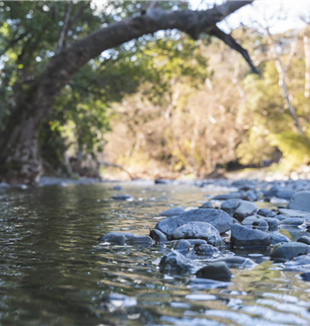
Pilgrim at Tinker Creek and The Religious Sense
Pilgrim at Tinker Creek by Annie Dillard points us, just as Fr. Giussani does, to the person’s original need for truth, beauty, and happinessThe book Pilgrim at Tinker Creek is an old favorite of mine, one that I tend to keep on my bedside table. I like it to be handy so I can pick it up on a whim and read a few pages of Annie Dillard’s masterful prose. So I was quite pleased when I learned that Pilgrim was Well-Read Mom’s book selection for the month of June. As I re-read the familiar words, I was struck by something new — the correspondence of Dillard’s point of view with Giussani’s The Religious Sense. With our School of Community’s work on the first part of The Religious Sense fresh in my mind, it became evident that Dillard does not shy away from the deep questions that constitute the human being, that she is sharply aware of her original need for truth, beauty, and happiness.
Pilgrim at Tinker Creek is a work of nonfiction about Dillard’s experiences at the creek in her backyard. Her detailed observations reveal her awe in front of even the smallest, most ordinary creature — a frog, a praying mantis, an amoeba. “I walk out; I see something, some event that would otherwise have been utterly missed and lost; or something sees me, some enormous power brushes me with its clean wing, and I resound like a beaten bell.” She is a human seeking to be fully alive, as Giussani describes in The Religious Sense: “Depending upon the measure of our human vivacity, anything whatsoever that enters our personal horizon (even a single blade of grass, or a pebble that we might kick with our foot) moves us, touches us, provokes a reaction.”
Annie Dillard’s human vivacity is so apparent, so urgent, that it becomes an invitation for me to follow, to come and see:
What do we think of the created universe, spanning an unthinkable void with an unthinkable profusion of forms? …in making the thick darkness a swaddling band for the sea, God ‘set bars and doors’ and said, ‘Hitherto shalt thou come, but no further.’ But have we come even that far? Have we rowed out to the thick darkness, or are we all playing pinochle in the bottom of the boat?…The answer must be, I think, that beauty and grace are performed whether or not we will or sense them. The least we can do is try to be there.
The least I can do is try to be there, to be present – to see and experience the reality that surrounds me. Only then can I determine what corresponds to my longings, my needs. Urged by Dillard’s provocation, as I read I began to appreciate the weight and importance of the “now.”
As Giussani states, “The more one is involved with life, the more one also, even within a single experience, comes to know the very factors of life itself.” It is clear through Dillard’s words that she is striving to “know the very factors of life itself.” She turns the intensity of her gaze upon the sliver of the natural world in her backyard, and is often rewarded by a moment of grace. “I might see anything happen; I might see nothing but light on the water. I walk home exhilarated or becalmed, but always changed, alive.”
I see the same thing happen to myself as I read her words alongside The Religious Sense. I experience a desire to get involved, to stop staring at my phone and instead look around. Out on a neighborhood walk, I spotted a roly-poly on the sidewalk. I bent down and pointed it out to my three-year-old son. We looked at the insect; my son asked about what it eats. We regarded this tiny aspect of nature, and suddenly I realized that my son and I are together, that we are in the world, that I love him and it is a joy to be his mother. I am grateful for Annie Dillard’s book, which sharpens my perception of the world around me. Her words prepare me to better read Fr. Giussani’s. His words, in turn, awaken my heart.
Meredith, Sacramento, CA